ABCs of POY & ROY

2009 Recap: Nikko Locastro & Valarie Jenkins – Players of the Year. Jeremy Koling & Jayne Snider – Rookies of the Year.
The purpose of this article, besides sharing the full 2009 results, is to really get into the nitty-gritty for the ‘hows and whys’ of our new process based 100% on stats to determine winners each year now that we have a full year of information to review.
The tables below show the final point standings for Players and Rookies of the Year. A final score of 10 would indicate a player won all three or four final factors used to determine the point totals. You can see it was a tight finish among the men POY finalists from 2nd thru 5th.
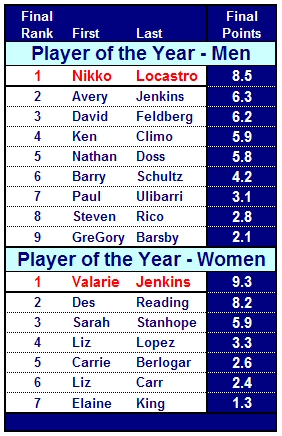
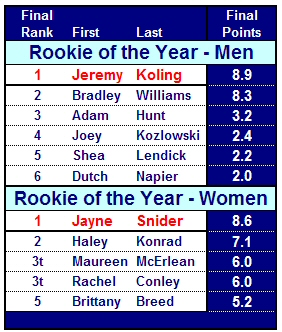
Click the first link to download the document showing the calculations. Click the other three links to see which events were included for each player who made it as finalists and a few who just missed the cut.
These documents will be referenced throughout this discussion if you wish to follow along in detail. Note that the top 7 women and men plus ties make it into the finals for Players of the Year (POY). The top 6 plus ties make it into the finals for Rookies of the Year (ROY).
How to Become a Finalist
Some have questioned whether enough events are included for determining the finalists. For POY, a player’s seven events with the highest average event rating where at least two are NTs, ETs (EuroTour) or Majors (excluding Worlds) are averaged to determine their standing. While the touring players enter over 20 events per year, the average PDGA player only enters between 5 to 7 per year, mostly B & C tiers.
There are many great players who can’t take the time off to tour. So the thought was that seven events of the type needed could reasonably be played during a year by any PDGA member, including international players, who really wanted to make the effort to qualify for these awards. Regardless, the more events you play the better your chances of stringing together a better set of events to become a finalist. So it should be no surprise that only touring players made the finals for POY. Note that top tour players, Cale Leiviska and Josh Anthon, only missed the cut to the finals by one rating point.
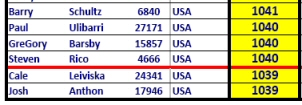 Had either played another event with a smokin’ finish or made one or two more putts in any of their best events, they could have made the cut by tying or topping Steve Rico, Paul Ulibarri and Gregory Barsby tied at 1040 best event ratings to just make the finals.
Had either played another event with a smokin’ finish or made one or two more putts in any of their best events, they could have made the cut by tying or topping Steve Rico, Paul Ulibarri and Gregory Barsby tied at 1040 best event ratings to just make the finals.
For Rookies of the Year, only a player’s five best event ratings are used including at least one Major, NT or ET (excluding Worlds). While this doesn’t seem to be a problem to achieve for many of the rookie men, we didn’t have enough women this past year reach the minimum and have six finalists. With smaller fields, and many times no Women Open Pro division at events, it can be difficult for women to play enough suitable events in their area. However, somewhat surprising, no ROY women finalists played Worlds this past year. Hopefully, with more players understanding how these awards work, more will attempt to qualify as finalists this year and into the future.
For both men and women, only events played in the Open division count toward POY and ROY standings. Pro Women who sometimes enter Advanced or Intermediate Men or older pros entering Master Pro will not get credit for those events even if they blow away their field. For example, Elaine King won the Women Master Pro division at Worlds. However, for the POY calculation, a player like Elaine who did not enter Open at Worlds gets awarded the Worlds rating of the finalist who had the lowest rating at Worlds minus five more points.
Ranking the Finalists
While ratings do a good job determining how well each player does against each course, we also want to know how well players fared against each other. So, in addition to including a Finalist’s event rating at Worlds in the calculations, we added their percentage finish in their best events. And for the POY finalists only, their head-to-head performance against the other finalists in all of the events they all included in their sets of best events was determined by awarding one point for each finalist beaten in an event.

The reason Worlds is evaluated as a separate event from all other events is the number of rounds played. Most Worlds have 7 to 8 rounds before the Final 9 compared with a typical maximum of 4 and occasionally 5 rounds at all other A-tier and higher events. The more rounds played in an event, the harder it is to earn an event rating average too much higher than your rating.
Ideally, it’s good to have different evaluation factors that don’t completely parallel other factors where every finalist ends up ranked in the same order as another factor. The choices we made seem to be working at least for 2009 where none of the four winners swept every factor in the final calculation.

At least one or more other finalists won at least one factor. Annual overall money winnings or $$ per event, were considered as another factor. However, these were rejected because payouts and related calculations are too inconsistent and would also bias the rankings to those who play either more events or just bigger events.
Something that might be of interest for those really into the detailed calculations is how the ranking points are determined for each final factor. For starters, the finalist with the highest value for a factor – rating, percentage or H-t-H points – receives 10.00 points. The finalist with the lowest number for a factor value receives 1.00 points if the point spread between the top and bottom is at least 9 points apart. Everyone else gets points between 10.00 and 1.00 on a linear sliding scale proportional to their position in the spread between the top and bottom values for the factor.
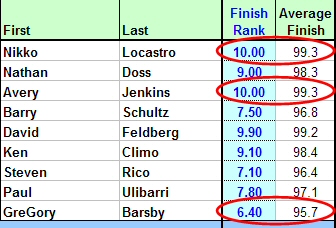 If the value spread is less than 9 points, such as the spread in Average Finish percentages for the male POY finalists, then the player with the lowest value earns the difference between the top and bottom values subtracted from 10.00. For example, Locastro and Jenkins had the best value at 99.3 %. Barsby had the lowest at 95.7% with the difference being 3.6%. We take 10.00 and subtract 3.6 and see that Barsby earned 6.40 points for that factor.
If the value spread is less than 9 points, such as the spread in Average Finish percentages for the male POY finalists, then the player with the lowest value earns the difference between the top and bottom values subtracted from 10.00. For example, Locastro and Jenkins had the best value at 99.3 %. Barsby had the lowest at 95.7% with the difference being 3.6%. We take 10.00 and subtract 3.6 and see that Barsby earned 6.40 points for that factor.
Finally, the point values each player receives (displayed in the Rank columns with blue text) are multiplied by the weighting percentages shown at the top of each column. The results of these multiplications are shown in the columns in the orange shaded section. The Total Pts column is the final point total that determines the final ranking of the players with a higher number being better.
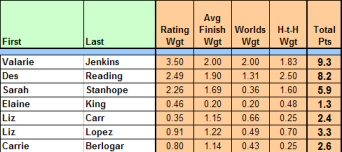 Note that the orange shaded values refer to the names to the left. Several of the names in the final ranking display section on the far right are in a different order than the original order. The weighting percentages being used are based on the collective overall opinion from the PDGA Staff and Board who have reviewed this process.
Note that the orange shaded values refer to the names to the left. Several of the names in the final ranking display section on the far right are in a different order than the original order. The weighting percentages being used are based on the collective overall opinion from the PDGA Staff and Board who have reviewed this process.
New for 2010
After going through this process, we have found some items to improve for 2010. This year, a player’s best Major/NT/ET event ratings will be double weighted. In addition, the head-to-head value will be adjusted to level the field a little more so finalists who play more events don’t have as much advantage. If these changes had been implemented for 2009, it wouldn’t have changed the winners. But it might make a difference in future close races.
We hope to post the initial standings earlier in the year, hopefully in July before Worlds. There aren’t enough players who have enough qualifying events reported to the PDGA to post standings before mid-year. High on the PDGA tech projects list is to add a new column in the player stats area to display a player’s average event rating for each event so they don’t have to calculate that to see how they are doing. But there are no promises on when that might be ready.
- posted 36 min ago
- posted 47 min ago
- posted 20 hours ago
- posted 6 days ago
- posted 1 week ago
- 1 of 727
- next ›
